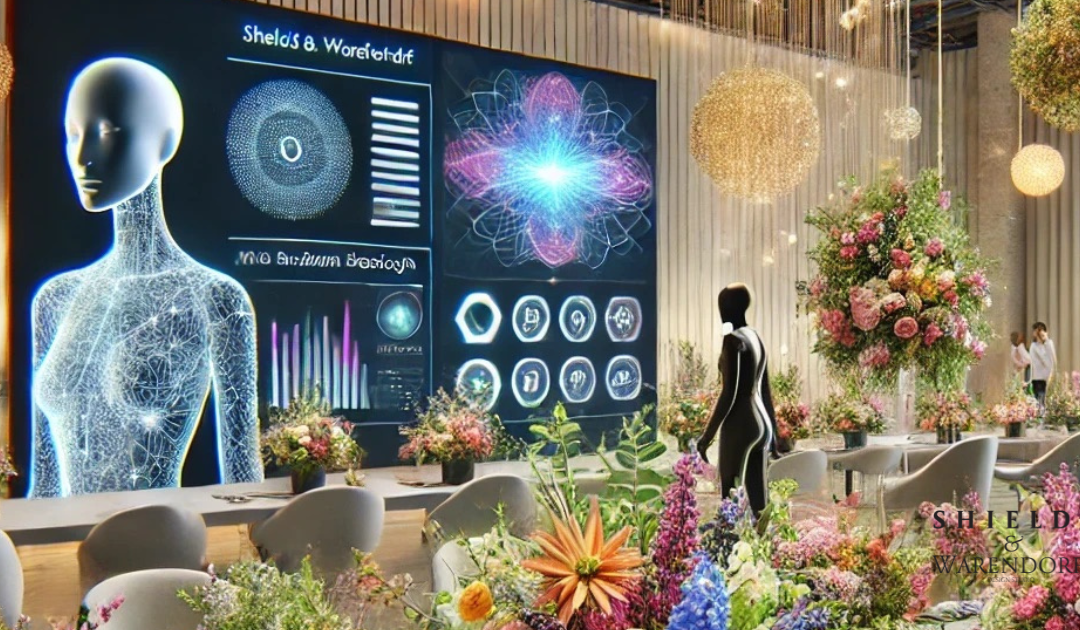Artificial intelligence (AI) is revolutionizing industries worldwide, and the event planning and floral design sectors are no exception. As technology rapidly evolves, AI is reshaping how event planners and florists approach creativity, logistics, and client satisfaction. With the ability to streamline processes, predict trends, and enhance design capabilities, AI is a game-changer that is creating new possibilities for event professionals. This blog explores how AI is transforming the floral design world and what the future holds for the intersection of technology and creativity.
1. Automation of Floral Design Processes
AI is playing a vital role in automating many of the time-consuming tasks involved in floral design. From generating mood boards to recommending flower pairings based on client preferences, AI-driven tools can help designers visualize their concepts more efficiently. AI can analyze a client’s inspiration images, budget, and style to suggest arrangement ideas, reducing the time needed for creative brainstorming.
Floral arrangement algorithms, for example, use AI to arrange flowers in aesthetically pleasing ways while considering factors like color theory, flower shape, and seasonal availability. This not only saves time but also enhances the overall design process, allowing florists to experiment with combinations they may not have previously considered.
In addition, AI tools that automate supply chain management help florists ensure they have the right flowers at the right time, reducing wastage and improving efficiency. From ordering and tracking to inventory management, automation enhances the logistical aspects of floristry.
2. Personalization Through Data Analysis
One of AI’s biggest advantages in event planning is its ability to analyze large datasets and personalize experiences. When it comes to floral design, AI can help florists tailor arrangements to meet the specific tastes and preferences of their clients. By analyzing customer data, such as previous purchases, event themes, and regional trends, AI systems can suggest customized flower selections that align with the client’s style and needs.
For instance, predictive analytics can help event planners and florists forecast which types of flowers will be in demand based on the time of year, location, and current trends. This enables florists to offer clients flowers that are not only beautiful but also on-trend, enhancing client satisfaction. AI can also recommend flowers that have personal significance to the client, such as those that are culturally meaningful or tied to important memories, adding a deeper level of personalization to the event.
3. AI-Powered Design Inspiration
The creative side of floral design is being enhanced by AI’s ability to predict and suggest design concepts. Through machine learning, AI can analyze past floral arrangements and current design trends to recommend new, innovative designs. Whether it’s a wedding, corporate event, or themed gala, AI-powered tools can provide inspiration and ideas that florists might not have thought of on their own.
Some AI platforms use image recognition technology to analyze photographs of floral arrangements, extracting design elements such as color schemes, flower types, and arrangement styles. This allows florists to quickly replicate or adapt designs based on real-world examples, offering clients cutting-edge floral creations.
Additionally, AI systems can integrate with virtual reality (VR) to provide a more immersive experience for clients. With VR and AI, clients can walk through a 3D virtual model of their event space and see how different floral arrangements would look in real time. This gives clients the chance to provide immediate feedback, reducing the need for revisions and improving the overall client experience.
4. Sustainability and AI: Reducing Waste
Sustainability is becoming a top priority for event planners and florists, and AI is helping make the floral design process more eco-friendly. AI can analyze data on flower production, transportation, and seasonal availability to recommend sustainable choices. For example, AI can suggest locally grown, in-season flowers that reduce carbon footprints, or provide insights into flower varieties that require less water and energy to cultivate.
AI also plays a role in minimizing waste by optimizing flower usage. Advanced algorithms can calculate the exact number of flowers needed for an arrangement, reducing the chances of over-ordering. Florists can use AI to plan floral designs that make the most of available resources, creating beautiful arrangements while limiting excess.
AI’s role in waste reduction extends to event logistics as well. By predicting how much material will be needed for a specific event and optimizing delivery schedules, AI can help event planners reduce the environmental impact of transportation and storage.
5. Enhanced Customer Interaction and Experience
AI is also transforming how florists and event planners interact with clients. Chatbots powered by AI can answer customer questions, provide event recommendations, and even assist with booking services—all without the need for human intervention. These chatbots are available 24/7, offering clients immediate support and improving customer satisfaction.
Moreover, AI can track customer interactions to offer personalized event recommendations based on a client’s preferences. For example, if a client frequently books certain types of events, AI can suggest floral arrangements and event styles that align with their past choices. This tailored approach makes clients feel valued and understood, which is key to building long-lasting relationships.
AI-driven customer relationship management (CRM) systems also make it easier for florists and planners to keep track of client preferences, communication history, and important dates like anniversaries and birthdays. This helps maintain a personalized touch with clients, ensuring that each interaction feels tailored and thoughtful.
6. Looking Ahead: AI as a Creative Partner
As AI technology continues to advance, the role of AI in floral design and event planning will only expand. AI is evolving from a simple tool to an active creative partner, offering designers a new way to explore their artistry. Far from replacing the creative touch of human florists, AI enhances it, allowing florists to push the boundaries of what’s possible in floral design.
In the future, AI may become even more integrated into the creative process, providing real-time feedback on designs, predicting emerging trends, and helping florists create arrangements that are not only visually stunning but also eco-conscious and tailored to the individual preferences of each client.
Conclusion
At Shields and Warendorf, we understand the new world of event planning and how AI is transforming the industry. We are committed to staying ahead of these technological advancements while maintaining the essence of what makes floral design an art. With AI’s ability to streamline logistics, provide personalized client experiences, and offer creative design insights, we are equipped to deliver unforgettable, on-trend events that reflect both innovation and beauty. As we look to the future, we embrace AI as a tool to enhance our creativity and sustainability efforts, ensuring that each arrangement we craft is not only visually stunning but also aligns with the values of efficiency and environmental responsibility. Whether it’s a grand event or an intimate gathering, Shields and Warendorf combines the best of both technology and tradition to bring your vision to life.
Written By DapraLab


